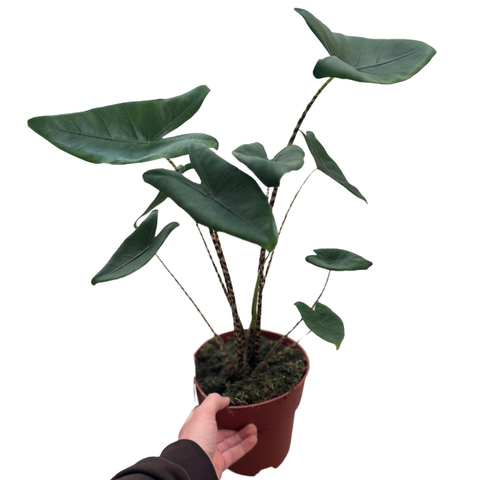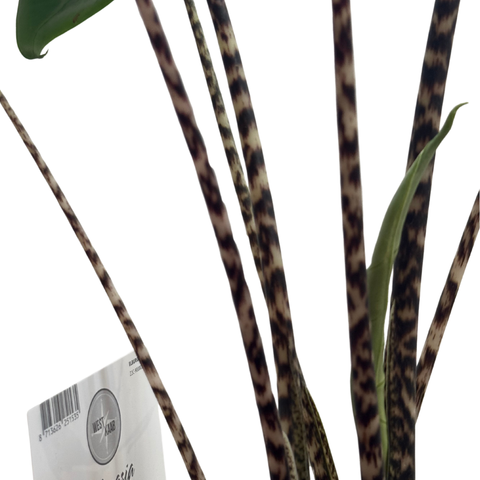

Large Alocasia Zebrina - Zebra Plant
Aroma Quartz📦 FREE SHIPPING OVER £40
Pot Size: 19cm Height Approx: 70cm
Alocasia zebrina
Common Names: Zebra Plant, Tiger Elephant Ear
Full Botanical Name: Alocasia zebrina
Country and/or Region of Origin: Native to the tropical regions of Southeast Asia, particularly the Philippines and Borneo
Overview
Alocasia zebrina is a striking and bold houseplant known for its large, glossy, arrow-shaped leaves and dramatic zebra-patterned stems. This plant’s unique combination of bold foliage and eye-catching stems makes it a standout piece in any indoor plant collection. It’s a fantastic choice for plant enthusiasts looking to add a touch of exotic flair to their space, though it does require a little more attention to thrive.
Growing Conditions in Native Habitat
In its native tropical forests, Alocasia zebrina grows in shaded, humid areas, often near streams and waterfalls. It prefers moist, well-drained soil and thrives under filtered light.
Care Guide
Light: Prefers bright, indirect light. Too much direct sunlight can scorch its delicate leaves, while too little light will result in slower growth and smaller leaves.
Ideal Room: Perfect for living rooms, bathrooms, or entryways with consistent natural light.
Feeding: Feed monthly during the growing season (spring and summer) with a balanced liquid fertilizer. Reduce feeding during the fall and winter months.
Humidity: Enjoys high humidity. Misting the leaves or placing the plant on a humidity tray will help keep it happy. It may struggle in dry environments, especially during winter.
Ideal Temperature: Thrives in temperatures between 65–80°F (18–27°C). Protect it from drafts and cold temperatures below 50°F (10°C), as it is sensitive to sudden temperature drops.
Watering: Keep the soil evenly moist but not soggy. Water when the top 1–2 inches of soil feel dry. Be cautious not to let the plant sit in water to prevent root rot.
Pet/Child Safe: Toxic to pets and humans if ingested, causing mild irritation. Keep out of reach of children and pets.
Soil Type: Use a well-draining, lightweight potting mix—preferably one formulated for aroids or tropical plants. Adding perlite or orchid bark improves drainage.
Propagation: Can be propagated via division during repotting. Ensure that each division has a healthy root system before planting.
Eventual Height and Spread: Can grow up to 3–4 feet (90–120 cm) tall, with leaves that can reach 12–18 inches (30–45 cm) in length. The plant’s spread depends on environmental conditions and pruning.
Growth Rate: Moderate to fast under optimal conditions, particularly in the spring and summer months.
Pests and Treatment: Prone to pests like spider mites, aphids, and mealybugs. Regularly inspect the leaves and treat with neem oil or insecticidal soap if needed.
Repotting: Repot every 1–2 years, or when the plant becomes root-bound. Choose a slightly larger pot with drainage holes to promote healthy growth.
Pruning: Remove dead or damaged leaves to maintain its striking appearance. Cut stems back to encourage new growth during the growing season.
Air Purification: Known for improving air quality by removing toxins, Alocasia zebrina can help purify the indoor environment.
Folklore: In tropical cultures, Alocasia plants are considered symbols of protection and strength. Their bold leaves and striking appearance are believed to bring positive energy and vitality to a space.
